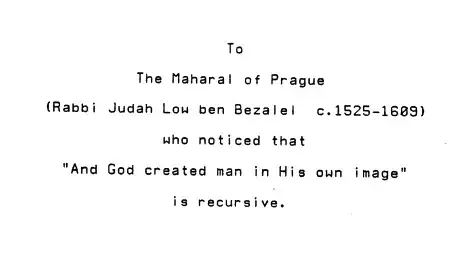Today I encountered a claim that Rabbi Judah Loew ben Bezalel (known as The Maharal of Prague) said that the statement "So God created mankind in his own image"
So God created mankind in his own image,
in the image of God he created them;
male and female he created them.
Genesis 1:27
The reference I found was in the footnotes of this article:
[2] In the dedication of this 1973 PhD thesis at the MIT Artificial Intelligence Lab, to the Maharal of Prague–the creator of the best known Golem, Gerry Sussman points out that the Rabbi had noticed that this line was recursive.
Steps Toward Super Intelligence I, How We Got Here
And the thesis refrenced, was found here:
To
The Maharal of Prague
(Rabbit Judah Low ben Bezalel c.1525-1609)
who noticed that
"And God created man in His own image"
is recursive.
Dedication of "A Computational Model of Skill Acquisition"
However, despite all my searching, I can not find any actual reference to this claim. The best I can figure is that it has something to do with The Legend of the Golem and the fact that Rabbi Judah Loew ben Bezalel is its supposed maker. So did the Rabbi actually make this claim? Was is a posthumous attribution? Or did it come from somewhere else entirely?
